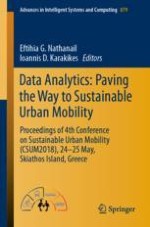This book aims at showing how big data sources and data analytics can play an important role in sustainable mobility. It is especially intended to provide academicians, researchers, practitioners and decision makers with a snapshot of methods that can be effectively used to improve urban mobility. The different chapters, which report on contributions presented at the 4th Conference on Sustainable Urban Mobility, held on May 24-25, 2018, in Skiathos Island, Greece, cover different thematic areas, such as social networks and traveler behavior, applications of big data technologies in transportation and analytics, transport infrastructure and traffic management, transportation modeling, vehicle emissions and environmental impacts, public transport and demand responsive systems, intermodal interchanges, smart city logistics systems, data security and associated legal aspects. They show in particular how to apply big data in improving urban mobility, discuss important challenges in developing and implementing analytics methods and provide the reader with an up-to-date review of the most representative research on data management techniques for enabling sustainable urban mobility
